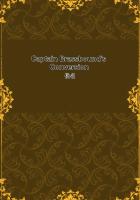compromise, bill the value of the English manufactured goods hasfar surpassed the value of the exported American products, and thatthereby the United States have become indebted to the English tothe amount of several hundreds of millions for which they could notpay in products.The proof that these crises are occasioned bydisproportionate importation is, that they have always taken placewhenever (in consequence of peace having set in or of a reductionbeing made in the American customs duties) importation ofmanufactured goods into the United States has been unusually large,and that they have never occurred as long as the imports of goodshave been prevented by customs duties on imports from exceeding thevalue of the exports of produce.
The blame for these crises has further been laid on the largecapital which has been expended in the United States in theconstruction of canals and railways, and which has mostly beenprocured from England by means of loans.The truth is that these inloans have merely assisted in delaying the crises for severalyears, and increasing it when it arose; but these very loansthemselves have evidently been incurred through the inequalitywhich had arisen between the imports and exports, and but for thatinequality would not have been made and could not have been made.
While North America became indebted to the English for largesums through the large importation of manufactured goods whichcould not be paid for in produce, but only in the precious metals,the English were enabled, and in consequence of the unequal ratesof exchange and interest found it to their advantage, to have thisbalance paid for in American railway, canal and bank stocks, or inAmerican State paper.
The more the import of manufactured goods into Americasurpassed her exports in produce, and the greater that the demandfor such paper in England became, the more were the North Americansincited to embark in public enterprises; and the more that capitalwas invested in such enterprises in North America, the greater wasthe demand for English manufactured goods, and at the same time thedisproportion between the American imports and exports.
If on the one hand the importation of English manufacturedgoods into North America was promoted by the credit given by theAmerican banks, the Bank of England on the other side through thecredit facilities which it gave and by its low rates of discountoperated in the same direction.It has been proved by an officialaccount of the English Committee on Trade and Manufactures, thatthe Bank of England lessened (in consequence of these discounts)the cash in its possession from eight million pounds to twomillions.It thereby on the one hand weakened the effect of theAmerican protective system to the advantage of the Englishcompetition with the American manufactories; on the other hand itthus offered facilities for, and stimulated, the placing ofAmerican stocks and State paper in England.For as long as moneycould be got in England at three per cent.the American contractorsand loan procurers who offered six per cent interest had no lack ofbuyers of their paper in England.
These conditions of exchange afforded the appearance of muchprosperity, although under them the American manufactories werebeing gradually crushed.For the American agriculturists sold agreat part of that surplus produce which under free trade theywould have sold to England, or which under a moderate system ofprotection of their own manufactories they would have sold to theworking men employed therein, to those workmen who were employed inpublic works and who were paid with English capital.Such anunnatural state of things could not, however, last long in the faceof opposing and divided national interests, and the break up of itwas the more disadvantageous to North America the longer it wasrepressed.As a creditor can keep the debtor on his legs for a longtime by renewals of credit, but the bankruptcy of the debtor mustbecome so much the greater the longer he is enabled to prolong acourse of ruinous trading by means of continually augmented creditfrom the creditor, so was it also in this case.
The cause of the bankruptcy in America was the unusual exportof bullion which took place from England to foreign countries inconsequence of insufficient crops and in consequence of theContinental protective systems.We say in consequence of theContinental protective systems, because the English -- if theEuropean Continental markets had remained open to them -- wouldhave covered their extraordinary importations of corn from theContinent chiefly by means of extraordinary export of Englishmanufactured goods to the Continent, and because the Englishbullion -- even had it flown over for a time to the continent --would again have found its way back to England in a short time inconsequence of the augmented export of manufactured goods.In sucha case the Continental manufactories would undoubtedly have fallena sacrifice to the English-American commercial operations.
As matters stood, however, the Bank of England could only helpitself by limiting its credit and increasing its rate of discount.















